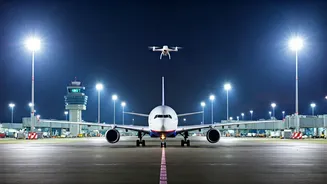Drone Sightings Surge
The occurrence of drone-related incidents at European airports has significantly risen, with these unmanned aerial vehicles causing major disruptions.
Often, these drones are sighted near or within the airspace of busy airports, leading to flight suspensions and operational delays. The frequency of these events has varied across different locations, but the underlying challenge remains consistent: ensuring the safety and security of air travel. Several airports experienced multiple shutdowns due to these incidents, causing inconvenience to travellers and financial strain on airlines. The sudden and unannounced appearance of these drones has triggered investigations, aiming to identify the source and intentions behind these flights.
Flight Operations Hampered
The primary effect of the drone intrusions has been the suspension of flight operations. When drones are detected in the vicinity of an airport, standard protocols often require the immediate grounding of flights, both incoming and outgoing, to ensure that there are no collision risks. This process can extend for periods ranging from a few minutes to several hours, depending on the severity of the threat and the effectiveness of the response. The impact of these flight suspensions has been extensive, resulting in delayed flights, missed connections, and increased passenger stress. Moreover, the disruptions have ripple effects, influencing the broader network of air travel and impacting schedules across multiple airports and countries. Airlines and airport authorities have had to manage these disruptions, providing affected passengers with information, assistance, and rebooking options.
Security Concerns Arise
The unauthorized drone flights have raised substantial security concerns within the aviation sector. The presence of drones near critical infrastructure, such as airports, poses a potential threat. It is possible these drones could be used for malicious activities, including reconnaissance, the transportation of dangerous materials, or even physical attacks. The increasing sophistication of drone technology, coupled with its accessibility, has amplified these concerns. Airport authorities, government security agencies, and law enforcement entities are now under pressure to develop and implement effective counter-drone strategies. These strategies may involve a combination of technologies, regulations, and operational adjustments designed to detect, track, and mitigate drone-related threats.
Countermeasures Implemented
In response to the growing drone threat, a variety of countermeasures have been developed and put into place across European airports. These range from basic surveillance methods, such as enhanced radar systems and visual monitoring, to more advanced technologies like radio frequency detectors and drone jammers. Some airports are also experimenting with drone-detection systems that employ cameras, sensors, and artificial intelligence to identify and track drones in real time. Regulations regarding drone operation near airports are being reviewed and updated to include stricter penalties and enforcement mechanisms. Collaboration between airports, aviation authorities, and security agencies is crucial for the effective implementation and maintenance of these countermeasures, ensuring that security measures are constantly adapted to address emerging threats.
Investigations Underway
Official investigations are underway to identify the source and purpose of the drone flights that have disrupted European airports. These investigations often involve analyzing data from radar systems, studying drone flight paths, and gathering any available information from eyewitness accounts. Law enforcement agencies are using these leads to trace the drones back to their operators, which is often difficult due to the nature of drone operations and the potential for anonymity. The goal is to determine the intent behind these flights – whether they are malicious, accidental, or merely a form of mischief – and to bring those responsible to justice. The outcomes of these investigations are crucial for the development of effective strategies to prevent future incidents and enhance the security of the aviation sector.















